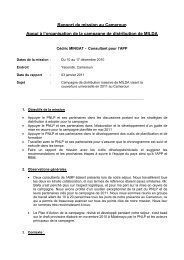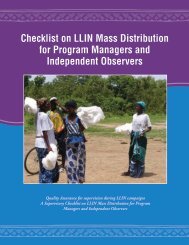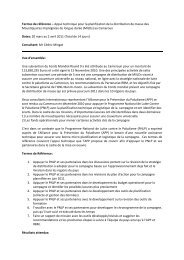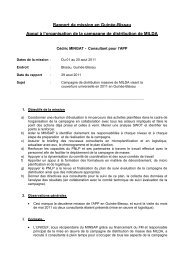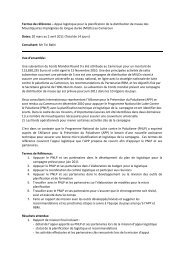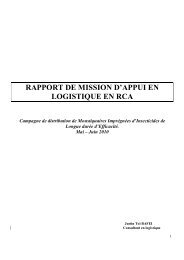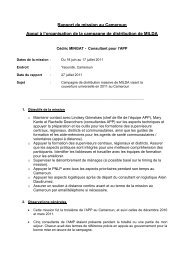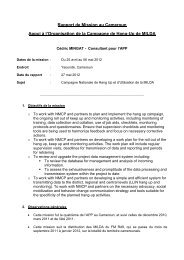Spots - Roll Back Malaria
Spots - Roll Back Malaria
Spots - Roll Back Malaria
- No tags were found...
Create successful ePaper yourself
Turn your PDF publications into a flip-book with our unique Google optimized e-Paper software.
ANNEX 4: GLOSSARYRADIO PRODUCTIONFade-out: Decrease the sound from normal down to zero.Fade-down: Lower the volume but not completely; often used like fade-under.Fade-under: Lower the volume of other sounds to make another sound, usuallyvoice, prominent.Musical bed: The mixture of voices and music in which the voices are in theforeground and the music in the background.Musical curtain: The use of music to change or end scenes or moods.Narrator (or announcer): A neutral person (one who is not playing a specificcharacter) who reads the script.Pause: A brief time, usually no more than two seconds, in which no sound is heard.Program closing: The ending of a radio program that is similar to the programopening. It usually invites people to listen to the next program and gives the time,date and what the next program will be about.Program opening or signature: A standardized opening that uses the same musicaltheme, sound effects and voices to help the listener identify the program quickly.Script: The format for writing radio materials. It is the blueprint or map that permitsyou to produce the radio materials efficiently.Splice: A technique that combines two pieces of a radio material, often by taping theends of recording tape together.Sound effects: Any sound occurring in radio material that is not voice or music.Sound effects are natural or artificial.Transition: A phrase, piece of music or sound effect used to separate scenes orportions of a broadcast, or to signify the end of a scene. A transition also canresolve the mood of one scene and set the mood for the following scene.Clip: A segment of audio, of any length.Control room: Room that contains all the broadcast equipment. Usually connectedwith the studio via soundproofed window and talk-back system.Cue: To prepare a tape or CD for playing, or signal host or other on-air talent to startspeaking.Dub: To make a copy by transferring sound from one medium to another, such astape to tape, tape to computer, computer to CD.Levels: Volume at which sound is being recorded or transmitted; usually monitoredby a VU meter156 Spot On <strong>Malaria</strong>: Guide




